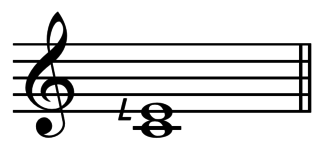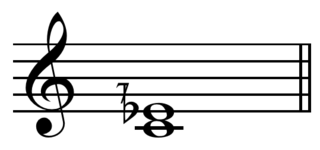Top Qs
Timeline
Chat
Perspective
7-limit tuning
Musical instrument tuning with a limit of seven From Wikipedia, the free encyclopedia
Remove ads
7-limit or septimal tunings and intervals are musical instrument tunings that have a limit of seven: the largest prime factor contained in the interval ratios between pitches is seven. Thus, for example, 50:49 is a 7-limit interval, but 14:11 is not.



 .[1] This, "extremely large third", may resemble a neutral third or blue note.[2]
.[1] This, "extremely large third", may resemble a neutral third or blue note.[2]
For example, the greater just minor seventh, 9:5 (ⓘ) is a 5-limit ratio, the harmonic seventh has the ratio 7:4 and is thus a septimal interval. Similarly, the septimal chromatic semitone, 21:20, is a septimal interval as 21÷7=3. The harmonic seventh is used in the barbershop seventh chord and music. (ⓘ) Compositions with septimal tunings include La Monte Young's The Well-Tuned Piano, Ben Johnston's String Quartet No. 4, Lou Harrison's Incidental Music for Corneille's Cinna, and Michael Harrison's Revelation: Music in Pure Intonation.
The Great Highland bagpipe is tuned to a ten-note seven-limit scale:[3] 1:1, 9:8, 5:4, 4:3, 27:20, 3:2, 5:3, 7:4, 16:9, 9:5.
In the 2nd century Ptolemy described the septimal intervals: 21/20, 7/4, 8/7, 7/6, 9/7, 12/7, 7/5, and 10/7.[4] Archytas of Tarantum is the oldest recorded musicologist to calculate 7-limit tuning systems. Those considering 7 to be consonant include Marin Mersenne,[5] Giuseppe Tartini, Leonhard Euler, François-Joseph Fétis, J. A. Serre, Moritz Hauptmann, Alexander John Ellis, Wilfred Perrett, Max Friedrich Meyer.[4] Those considering 7 to be dissonant include Gioseffo Zarlino, René Descartes, Jean-Philippe Rameau, Hermann von Helmholtz, Arthur von Oettingen, Hugo Riemann, Colin Brown, and Paul Hindemith ("chaos"[6]).[4]
Remove ads
Lattice and tonality diamond
| 7/4 | ||||||
| 3/2 | 7/5 | |||||
| 5/4 | 6/5 | 7/6 | ||||
| 1/1 | 1/1 | 1/1 | 1/1 | |||
| 8/5 | 5/3 | 12/7 | ||||
| 4/3 | 10/7 | |||||
| 8/7 |
This diamond contains four identities (1, 3, 5, 7 [P8, P5, M3, H7]). Similarly, the 2,3,5,7 pitch lattice contains four identities and thus 3-4 axes, but a potentially infinite number of pitches. LaMonte Young created a lattice containing only identities 3 and 7, thus requiring only two axes, for The Well-Tuned Piano.
Approximation using equal temperament
It is possible to approximate 7-limit music using equal temperament, for example 31-ET.
Remove ads
Ptolemy's Harmonikon
Claudius Ptolemy of Alexandria described several 7-limit tuning systems for the diatonic and chromatic genera. He describes several "soft" (μαλακός) diatonic tunings which all use 7-limit intervals.[7] One, called by Ptolemy the "tonic diatonic," is ascribed to the Pythagorean philosopher and statesman Archytas of Tarentum. It used the following tetrachord: 28:27, 8:7, 9:8. Ptolemy also shares the "soft diatonic" according to peripatetic philosopher Aristoxenus of Tarentum: 20:19, 38:35, 7:6. Ptolemy offers his own "soft diatonic" as the best alternative to Archytas and Aristoxenus, with a tetrachord of: 21:20, 10:9, 8:7.
Ptolemy also describes a "tense chromatic" tuning that utilizes the following tetrachord: 22:21, 12:11, 7:6.
Remove ads
See also
References
External links
Wikiwand - on
Seamless Wikipedia browsing. On steroids.
Remove ads
